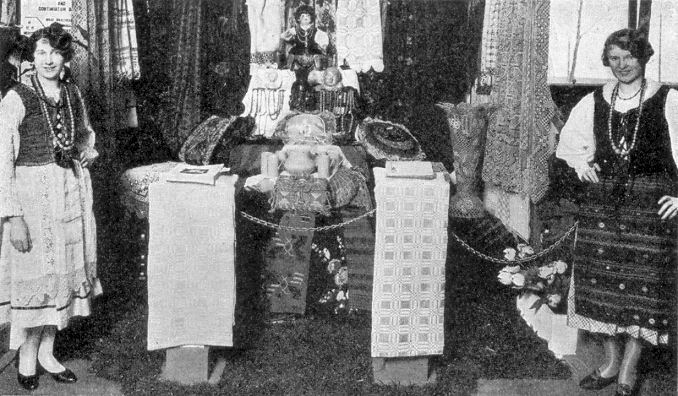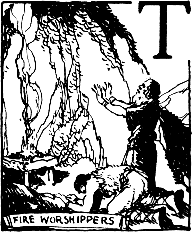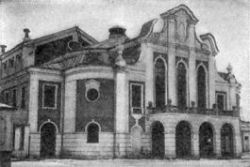 EXHIBIT OF LITHUANIAN COTTAGE INDUSTRIES
EXHIBIT OF LITHUANIAN COTTAGE INDUSTRIESThis display is of work done by Lithuanian women in their homes. The characteristic tulip design is developed in the work here displayed. The Lithuanian girls are in their national costumes.
LITHUANIA
 HE
Lithuanians belong to the Aryan race and are believed to have come
originally from Asia by way of the Balkans, as the Danube River is described in
Lithuanian folk songs. Their legends tell that they once lived along the shores
of an ocean (probably the Black Sea) and that their gods told them to journey
on and on until they came to the shores of another sea (the Baltic).
HE
Lithuanians belong to the Aryan race and are believed to have come
originally from Asia by way of the Balkans, as the Danube River is described in
Lithuanian folk songs. Their legends tell that they once lived along the shores
of an ocean (probably the Black Sea) and that their gods told them to journey
on and on until they came to the shores of another sea (the Baltic).
Little is known of the early history of Lithuania. A flat seacoast country, it was easily invaded, and its folk songs tell of raids by the Vikings.
“'Twas not the North wind,
Nor swollen river,
* * * * * * *
In the night's darkness
From the sea, men came.”
The early Lithuanians were fire worshipers, and long after the surrounding countries were Christianized, they clung to their heathen gods. The Lithuanian language is one of the oldest spoken languages today, and is strikingly similar to the old Greek and Latin. In the twelfth century the Teutonic Knights, a German military order, invaded Prussia and the other Baltic countries, conquered the people of Latvia, and completely destroyed the Old Prussians who chose to die fighting rather than give up their religion. The Old Prussians were much closer related to the Lithuanians than are the present Latvians. The Lithuanians, warned by the fate of their kindred neighbors, united under a native prince. After defeating the German Knights they began a campaign which extended their kingdom into western Russia and almost to the Black Sea. Grand Duke Olgird (Algirdas) thrice besieged Moscow. Grand Duke Vitold (Vytautas), called "The Great," stopped the Tartar invasion into Western Europe.
In the fourteenth century the reigning Grand Duke Jogaila (Polish, Jagiello) of Lithuania married Jadwiga, the youthful queen of Poland, thus uniting the two countries. For a time the two nations had separate governments but soon Lithuania became in fact subject to Poland. The Lithuanian ruling class became Polonized but the Lithuanian peasants preserved their language and customs during the period of union with Poland and later under Russia.
 STATE OPERA HOUSE AT KOVNO
STATE OPERA HOUSE AT KOVNOWhen the Poland-Lithuanian state was divided, at the end of the eighteenth century, the greater part of Lithuania went to Russia, and the remainder to Germany. Under foreign rule all Lithuanian race feeling seemed lost; the children were not allowed to learn their own tongue, nor the fathers to speak it; nevertheless the language and old customs did not die out, and the nineteenth century saw the awakening of national feeling.
Russia's disorganization in the World War gave Lithuania a chance to demand and receive national independence, and, after repulsing German and Bolshevist invasions, Lithuanian independence was proclaimed in 1918 at Vilna, the capital of Lithuania, and was recognized by the United States in 1922. Vilna, the historic capital of Lithuania, was seized by the Poles in 1920 by force, because the Lithuanians refused to renew the old Polish Lithuanian union. Lithuania does not recognize this annexation and still claims Vilna as its capital.
Though the land is not fertile, the chief occupation of the people is farming. The leading crops are rye and potatoes, and considerable quantities of flax are grown. Most of the peasants own their small farms. One-fourth of the country is forest. There are large pasture areas and some boggy land.
Meat packing and leather industries are rapidly developing in Lithuania. Cottage industry, because of the fine linen weaving done by the peasant women, is well developed. A striking characteristic of the national dress of Lithuanian women is the wearing of many strings of amber beads. Raw amber in large quantities is found along the entire Baltic seacoast of Lithuania.
Although long suppressed, the people have developed a multitude of charming folk songs and stories, and they have produced the writer, Christian Duonelaitis, who in the early part of the eighteenth century created a beautiful poem called The Four Seasons in hexameter which can compare with masterpieces by contemporary poets. Education has been stimulated by the introduction of general compulsory education and by the opening of the University of Kovno (Kaunas), with 800 students in 1922. Kovno, the temporary capital while Vilna is under Polish occupation, is the most important commercial center of the republic. Lithuania is on the route of the Paris to Leningrad Railway and this location is regarded as of great importance. Memel (Klaipeda), at the mouth of the Niemen (Nemunas) River on the Baltic Sea, is Lithuania's only seaport.
 Gallery
Gallery